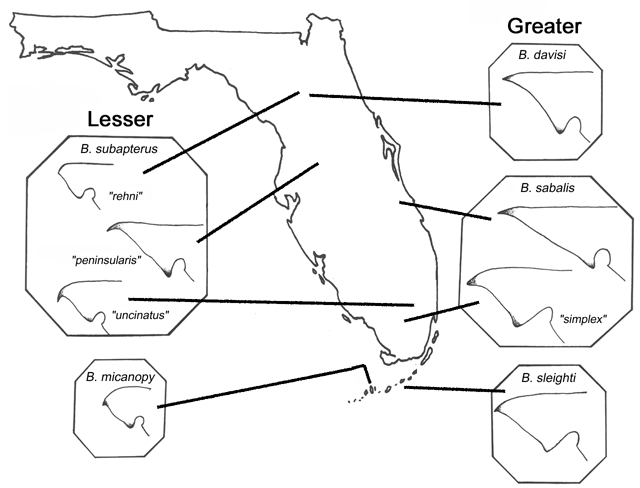Genus Belocephalus
short-winged coneheads
| Key to genera of coneheaded katydids (Copiphorinae). |
In Belocephalus, the wings of males cover less than half of the abdomen; wings of females are tiny and do not overlap. There is a prominent gap between the cone and face, and the tip of the cone is straight-pointed, bent-pointed, or rounded. Length 24-50 mm.
Species groups and species
The populations of short-winged coneheads (Belocephalus) fall readily into two species groups: greater short-winged coneheads, represented by sabalis, davisi, and sleighti, and lesser short-winged coneheads, represented by subapterus and micanopy. No locality has more than two populations of Belocephalus, and, wherever two occur, one belongs to each group.
The two groups are characterized in the table below. For the first two traits, the compared specimens must be from the same locality.

In south Florida and along Florida's east coast, absolute size is sufficient to place adult Belocephalus in one species group or the other. Elsewhere members of the two groups are similar enough in size to require separation by other means. [See table above and the species pages of B. subapterus and B. davisi.]
Dividing each species group into component species is difficult. Because two distinguishable populations of the same group never occur together, each species group could be interpreted as constituting a single geographically varying species. However, for these reasons I recognize five species rather than two: Belocephalus subapterous and B. micanopy have distinctively different calling songs; B. sleighti is different in its seasonal life history from B. sabalis; and B. davisi and B. sabalis fail, for unknown reasons, to occupy the area that separates them. None of the five species recognized is known to be genetically continuous with any other (i.e., no areas of hybridization are known). Except for B. davisi and B. sabalis, the features that separate species belonging to the same group seem likely to maintain genetic isolation even if populations of two such species should eventually come in contact. The maps below show the geographic extent of species here recognized. The dotted line on the left-hand map demarks the transition between two types of male subgenital plates.

Belocephalus sleighti has two generations per year. All other species have one, with peak adult numbers occurring in late summer or fall. With the exception of B. davisi, singing continues throughout the winter into the following spring. Where the eggs are laid and how soon they hatch are unknown.
RemarksShort-winged coneheads cannot fly nor do they have other means of long-range dispersal. Morphological differences that developed when once continuous populations were fragmented by Pleistocene changes in sea level may still remain even though populations are again continuous. For example, over a distance of about ten miles just north of Frostproof, Florida, the subgenital plates of male B. subapterus change from the usual type to the "hebardi" type (see drawings on B. subapterus page). Specimens with intermediate-type plates occur here only in a narrow zone. Elsewhere the transition between the two types of plates has not been studied. (See the common true katydid for a more extensively studied similar case.)
Short-winged coneheads are frequently associated with small palms, especially the saw and cabbage palmettos, the two most abundant native palms of southeastern U.S. They conceal themselves between fronds and in the pleats of fronds. In some areas, all calling males occupy palms. Short-winged coneheads have been seen eating palm fronds--tough material but the jaws of these katydids appear suited to such a diet. Since short-winged coneheads are sometimes abundant in areas with no palms, they must not depend entirely on palms for either food or shelter. Juvenile and adult B. subapterus, and perhaps those of other species, feed on grass heads in the manner of common coneheads (Neoconocephalus).
Belocephalus is the only genus of coneheads restricted to the United States. Their closest relatives may be Pyrgocorypha spp.